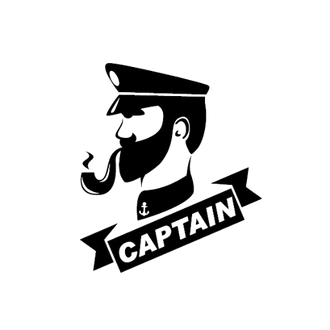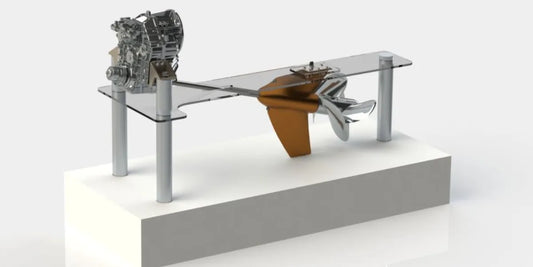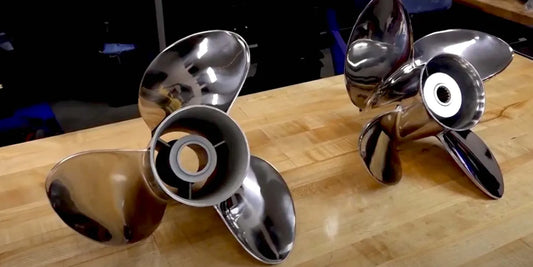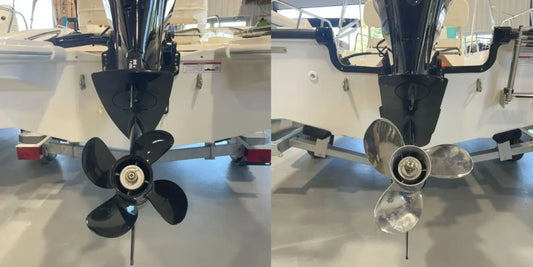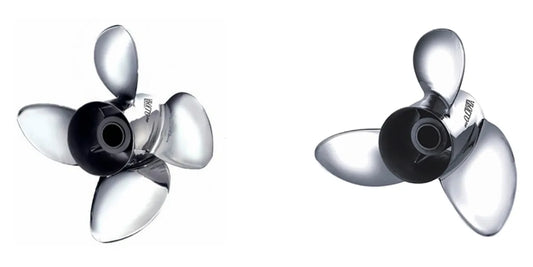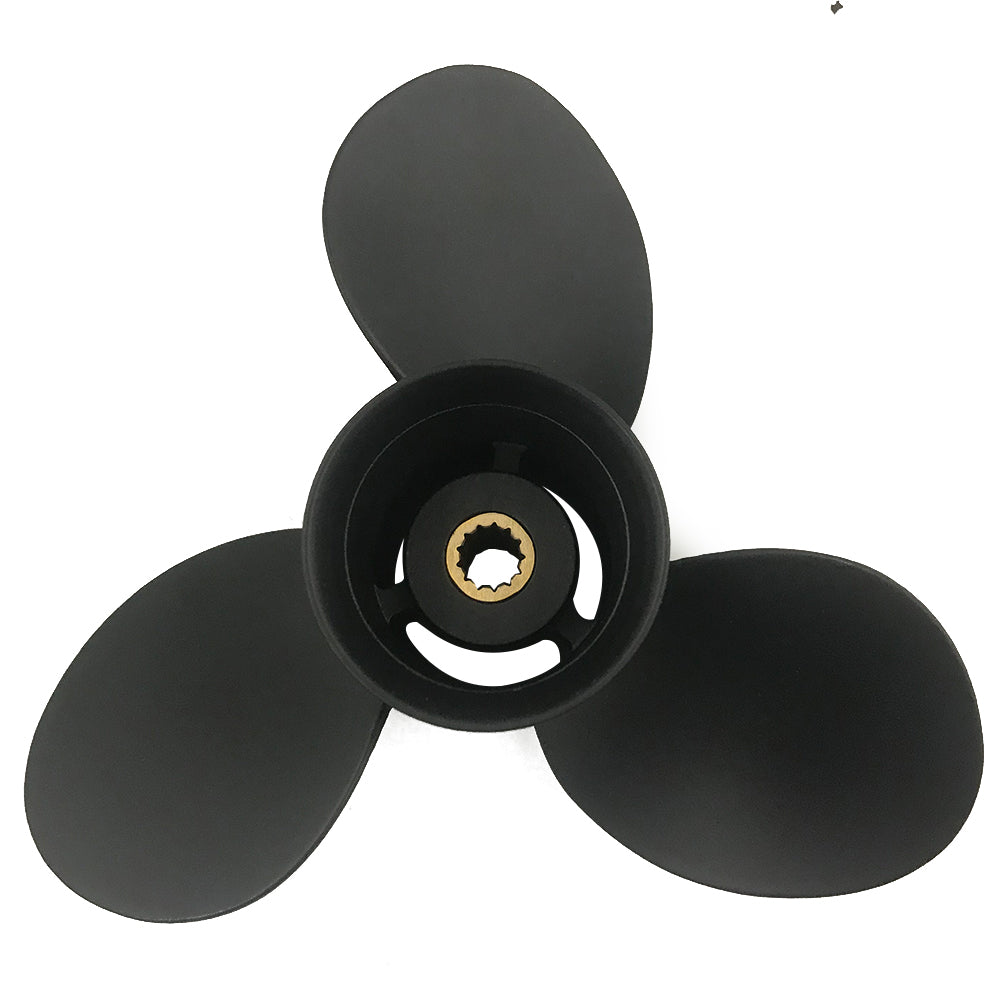The performance and efficiency of a vessel critically depend on its propeller, which is responsible for converting engine power to thrust. While on their way, boat propellers undergo wear and tear from water splashes, environmental conditions, operational stresses, and prolonged use, which result in diminished efficiency, higher fuel consumption, and safety hazards in some cases. In this blog post, we will explore the most effective methods used in propeller repairs for ships, focusing on modern techniques and best practices that restore the ship to working order, extend the propeller's lifespan, and enhance the vessel's overall performance. A must-read for an engineer, fleet manager, or maritime scientist endowed with the best knowledge to maintain propeller integrity.
Understanding Propeller Damage

The Kinds of Propeller Damage
Having varying operational and environmental conditions affecting vessel performance, efficiency, and safety, the various kinds of propeller damage are enumerated and explained below with respect to their causes and implications:
Cavitation Erosion: Cavitation occurs whenever the pressure of the liquid changes so rapidly that water vapor bubbles form over the propeller surface. The violent collapse of these bubbles produces impacts that gradually erode the propeller material. Damage of this nature is generally observed as pitting or blocking of surface layers and, if complex enough, might threaten the structural integrity of the propeller.
Blade Deformation: Physical impacts, such as collisions with submerged objects or debris, may cause bending or distortion of the propeller blade. Blade deformation disrupts hydrodynamic flow; hence, thrust efficiency is reduced, resulting in an increase in vibrations that, over time, may induce other mechanical faults in the propulsion system.
Corrosion: Propellers, particularly those made of metal alloys, can be corroded by prolonged immersion in seawater. Electrochemical reactions, particularly when coupled with inadequately managed cathodic protection systems, can deteriorate the metal, significantly reducing the propeller's lifespan.
Stress Fractures and Cracks: These can result from stresses induced by high-speed operations or uneven loadings, which can lead to fractures or small cracks on the propeller blades. Such defects may grow with time, culminating in a catastrophic failure if left unrepaired.
Biofouling Accumulation: The accumulation of marine organisms, like barnacles or algae, on the propeller surface roughens it and increases hydrodynamic drag. Consequently, this reduces efficiency, accelerates fuel consumption, and causes additional stress on the engine, thereby hastening its wear and tear.
Edge Wear and Dulling: A high-abrasion environment, combined with continuous and prolonged use, can wear the leading and trailing edges of the propeller blades. This dulls the edges, thereby affecting their hydrodynamic characteristics and thrust performance.
Knowing these types of damages enables recognizing the causes and leads to timely repairs or preventive maintenance initiatives. The more advanced diagnostic techniques, such as ultrasonic testing and hydrodynamic performance analysis, can also serve to detect and eventually correct problems prior to their arrival.
Causes of Propeller Damage
The list is quite long, demonstrating that propeller damage can have mechanical, environmental, or operational causes, with each factor contributing to the severity and nature of wear or failure. Some of the more prominent causes include cavitation, wherein rapid pressure changes in the water lead to the formation of vapor bubbles that then collapse violently against the propeller surface. With time, erosion, pitting, and material loss occur, thereby reducing the propeller efficiency.
Apart from that, heavy mechanical damage, such as dents, bends, or even fractures in the blade structure, may be inflicted due to collisions with submerged objects, including rocks, marine debris, or floating logs. Corrosion is another main culprit, especially in saltwater environments, which can attack if not otherwise protected. Agents such as aluminum and steel will suffer from it if not otherwise protected.
Damage to propellers can occur in the realm of operations. Improper shaft alignment, overloading of the propulsion system, or maladjustment of pitch can stress and accelerate fatigue cracking. Being laden with abrasive particles, sediment-laden water can cause gradual erosion wear along the leading or trailing edges of the blades.
Gathering data about and studying these mechanisms of damage is vital. For instance, some case histories illustrate that propellers in sedimented environments may suffer material loss estimated at 0.3 millimeters per year due to abrasion: if these are counteracted from the start by preventive maintenance, use of superior materials, or sheath protection, the life of the propeller can be considerably extended while keeping its performance at an optimum level.
The First Signs Indicating Propeller Repairs
To ensure the safe and efficient operation of the vessel, it is essential to identify early signs of wear or damage on the propeller proactively. Abnormal vibrations or noises during operation typically indicate blade imbalance or surface irregularities. Another possible symptom is inefficient propulsion or an unusual increase in fuel consumption resulting from deformation of the blades or cavitation-related damage. During a visual inspection process, the inspector may be able to detect indications of wear and tear, including pitting, cracking, or missing areas of the propeller. These may result from metal fatigue, corrosion, or accidents with debris. Even the most minor surface irregularity can lead to performance losses, thus making the issue a priority for inspection. Regular inspections and accurate measurement of blade geometries and surface conditions will help prevent failures and maintain standards for optimal performance.
Marine Propeller Repair Services

Choosing the Right Propeller Repair Service
A few key points must be considered when selecting an appropriate propeller repair service to ensure your marine propeller performs optimally for as long as possible. First, consideration is given to the service provider's skill and certifications; thus, a certified repair facility must be equipped with competent technicians and suitable equipment so that accurate diagnoses and responsible repairs can be carried out. Enquire about the techniques applied to adjustments of pitch, blade straightening, or dynamic balancing, as each of these impacts the efficiency and stability of the vessel's operation.
Another essential factor to consider is the presence of advanced inspection techniques, such as ultrasonic testing or 3D scanning, to properly detect material defects and ensure accurate repairs. The service turnaround time should be considered, as delays can severely affect operations, especially in commercial vessels. Furthermore, check to see whether the provider offers solutions to address wear and tear as part of preventive maintenance plans. With a sound decision, the performance of a propeller will be restored, and the service life extended, which in turn will provide some savings over time against the running cost.
What to Expect During Propeller Repair
Propeller repair is enabled to restore the artistry in a vessel, including performance. Initially, following a thorough inspection of the damage, which may include cracking, deformation, or cavitation wear on the blades, one or a cluster of advanced diagnostic tools can be employed, such as ultrasonic testing and dye penetrant inspections, to identify any hidden fractures or weaknesses in the propeller material. Then, after the analysis, it can be determined whether straightening, welding, or replacement of the blades is necessary.
Nowadays, repair utilizes modern techniques, ensuring the accuracy and durability of the procedure. For example, hydrodynamic analysis software can be used to optimize or enhance the propeller design during repairs. Precision grinding machines restore the blades to their original dimensions and balance, preserving rotational symmetry to the highest degree, which allows for the minimum vibration possible during operation. The surface treatment steps, such as polishing or applying a coating, are typically carried out after all structural repairs to enhance resistance to corrosion and marine growth.
Each step is guided by the requirements of industry standards, such as those from ISO or classification societies like ABS or DNV, to ensure the repaired propeller fulfills safety and performance certification. Of course, before reinstallation, quality assurance tests are usually conducted, from static balance tests to working trials. This entire process restores the propeller while also improving efficiency and longevity, making it more advantageous in terms of operational costs and fuel consumption in the long run.
Cost Factors in Propeller Repair Services
Pricing for propeller repairs depends on certain critical factors that govern the final pricing structure. These include the nature and extent of damage the propeller suffers, its material composition, and the approach to be adopted for the repair. Minor surface imperfections, such as scratches and pits, would typically be addressed through polishing and incidental welding, whereas gross structural damage to the propeller blades would necessitate blade replacement and rebalancing at significantly higher costs.
Material considerations equally come into play. That is, aluminum alloy propellers usually cost less to repair than those made from stronger and more expensive materials, such as nickel-aluminum bronze or stainless steel. These high-quality materials are robust; however, machining and welding of such materials requires a highly specialized process, which may thereby demand higher costs.
Additional cost elements include the logistics of transportation and handling, particularly for the large-scale propellers, as well as the associated turnaround time. Emergency or priority services, of course, carry premium pricing to support tight operational schedules. Adherence to regulatory standards, including material certification and specific quality assurance protocols, therefore increases technical complexity and total cost.
In any case, high-quality repair guarantees not only the structural integrity of the propeller but also its highest performance rating and most extended lifespan, minimizing potential future failure and thus operating costs in the long run.
Techniques for Effective Propeller Repair

Description of Welding Techniques for Damaged Propellers
Repairing damaged propellers involves welding, which is one of the primary skills, a procedure that must be performed with utmost precision and according to established technical standards. This manufacturing process typically involves gas tungsten arc welding (GTAW), including TIG welding, which requires precise welds of the highest quality. This technique can therefore be used to repair any crack, fracture, or severe wear on the blades of the propeller, which are typically fabricated from a variety of metals, including aluminum alloys, stainless steel, and bronze.
Before welding, adequate NDT is performed to assess the degree and location of the damage. The DPI or UT is often used for this purpose. After the damage is mapped, the affected area is carefully prepared through grinding and cleaning to ensure optimal weld adhesion. Pre-heating at a controlled temperature may be applied if the material requires it to minimize thermal distortion and enhance crack resistance.
Post-weld treatment is also vital to ensure that the repair is durable and safe. Heat treatment, also known as stress-relief annealing, is performed to restore the mechanical properties of the material and to reduce the residual stress induced during welding. Secondary NDT evaluations and dimensional checks are performed on the repaired zone to ensure structural integrity and conformity to the original design specification. Through a combination of advanced welding techniques and quality control measures, the reliability and performance of repaired propellers can be restored to operational standards.
Dynamic balancing of propeller blades
Dynamic balancing aids in the efficiency and durability of propellers. Investigating and rectifying the imbalance of a propeller blade dynamically simulates operating conditions. An imbalance causes severe vibrations, which stress the propeller and drivetrain components. This undue stress hastens wear and lowers efficiency.
Specialized instrumentalities ensure the dynamic balancing of mass distribution and rotational symmetry of the propeller during actual operation. Highly legged sensors with computer-aided balancing will examine and analyze vibration profiles at various rotational speeds. Based on this information, the technician will either add or remove weight, either by subtracting material from the blades or by using external balancing weights to achieve the required balance.
Recent developments in balancing equipment have improved the level of precision and efficiency. For instance, laser-guided systems and real-time data acquisition platforms provide an enhanced view of imbalance anomalies with significantly higher resolutions, allowing for precise adjustments. Research has shown that propellers that are properly balanced reduce vibration-induced fatigue by up to 30%, thereby ensuring the structure remains sound and performs well.
At the end of the day, dynamic balancing aids operators in meeting safety and regulatory standards while improving the life expectancy of propulsion systems and enhancing energy consumption efficiency during operation.
Precision Propeller Repair Methods
The precision of propeller repair involves a set of techniques that apply advanced diagnostic tools and expertise in hydrodynamics, combined with modern equipment, to restore optimal performance. Initially, an inspection with an emphasis on evaluation is performed to detect wear, deformation, or inconsistencies in the blade geometry. High-resolution metrology tools, such as laser scanners or CMMs, are used in this process, capable of achieving measurement accuracies within the micron level to detect even minute imperfections.
After diagnosis, surface damage is repaired while preserving the integrity of the propeller's original structure using either weld overlays or cold spray techniques. It is essential to ensure the compatibility of the materials for such repairs so that they can withstand adverse corrosion-promoting conditions in marine environments. Once repaired, precision grinding and polishing are performed to restore the hydrodynamic profiles of the surfaces, thereby reducing drag and improving propulsion efficiency.
Dynamic balancing is done last, and then the propeller is stress-tested under simulated operating conditions. Both procedures lead to an even distribution of weight and eliminate vibrational imbalance. Data indicate that up to 95% of the original performance specifications can be restored through advanced repair methods, thereby significantly extending the service life of the propellers while conforming to stringent marine engineering standards.
Underwater Maintenance for Marine Propellers

Benefits of Underwater Propeller Maintenance
An underwater propeller maintenance procedure offers various advantages, primarily focused on efficiency, cost-effectiveness, and operational continuity. If service operations can be carried out underwater, dry docking of the vessel becomes unnecessary. In this way, downtime can be kept to a minimum and operational disruptions minimized. Underwater maintenance is believed to reduce costs by 30-40% compared to traditional dry-docking, allowing vessels to stay on very tight schedules.
Regular underwater inspections and cleaning also tend to improve fuel efficiency by preventing the growth of marine organisms on propeller surfaces, which can create drag and reduce propulsion efficiency. Proved cases report an overall improvement in fuel efficiency of 10-15% upon removal of fouling, thereby reducing carbon footprints and net fuel consumption.
Enhancement of operational reliability occurs when underwater inspections unveil early signs of wear and tear, damage, or imbalances that could jeopardize propulsive systems. Timely intervention is thus afforded through the proactive approach, thereby considerably reducing the likelihood of an emergency or need for extensive repairs. Additionally, environmental concerns and regulatory compliance are taken seriously during underwater maintenance, and all methods used are formulated to minimize ecological impact, ensuring compliance with international maritime regulations.
Tools and Equipment for Underwater Repair
Underwater operations involve repairs and require specialized tools that have been engineered for performance under extreme hydrostatic, low-visibility, and high-precision environmental conditions, which demand safety considerations. Some essential tools include hydraulic and pneumatic systems, which are considered from the reliability point of view when submerged. Hydraulic impact wrenches and torque tools are used on fasteners, whereas hydraulic grinders are used for preparing surfaces. Structural repairs are carried out by sophisticated underwater welding systems, dry camera welding, or dry welding systems, thus ensuring integrity. Other exciting tools that are finding increased use are high-frequency induction heaters for metal joining and underwater coating removal.
Nowadays, underwater fixes are being accomplished with much precision and visibility: ROVs equipped with HD-resolution cameras and lighting systems. The ROVs carry out technical inspections and place tools at precise positions, thus reducing the risks divers may be exposed to. Additionally, ultrasonic thickness gauges and underwater laser scanning systems provide vital information for evaluating structural wear and damage. The other significant underwater applications of these adhesives and epoxy resins are for sealing and bonding. Based adhesives and epoxies can be applied underwater, giving strong sealing and bonding strength under dynamic conditions with high moisture.
Ensuring that underwater repair equipment maintains ecological and environmental safety standards, most underwater repair equipment is fabricated from non-toxic materials and features energy-conservation systems to minimize its ecological footprint, thereby working efficiently. The ability to perform underwater activities demands periodic testing, servicing, and calibration of these tools.
Best Practices for Underwater Maintenance
Pre-Assessment and Planning: Any underwater maintenance operation should precede the site assessment to identify any challenges posed by water depth, pressure, temperature, or environmental conditions. Consider the tools or materials to be used and examine whether they are suitable for the particular underwater environment. Proper planning reduces the risk and contributes to a smooth operation.
Use of Advanced Materials and Equipment: Modern advances in materials science have led to the development of various corrosion-resistant and underwater-use optimized adhesives. Consider using these state-of-the-art materials to achieve longer-lasting repairs. Additionally, ROVs can be effectively employed to perform repairs and inspections in hard-to-reach areas or hazardous conditions.
Practical Diver Training and Safety Protocols: All personnel involved in underwater maintenance must adhere to safety guidelines, emergency procedures, and technical practices. Certified divers for underwater repairs must have specialized skills to ensure safe repair operations and comply with stringent safety rules. Moreover, continuous communication between surface teams and underwater divers during operations guarantees efficient coordination.
Environmental Considerations: It is crucial to protect marine habitats during maintenance activities. Avoid substances that may leach toxic compounds into seawater, and ensure the disposal or containment of debris generated during repair activities. Environmental impact assessments should be conducted for works carried out in the vicinity of sensitive ecosystems to ensure that all applicable regulatory standards are met.
Routine Inspections and Predictive Maintenance: Periodic underwater inspections shall be conducted to assess the condition of subsurface structures and detect the onset of wear and/or damage. Utilize predictive maintenance through sensor technology and data analytics to prevent problems and minimize emergency repairs.
Documentation and Monitoring: Keep detailed records of maintenance actions, including site conditions, repair methodologies used, material types employed, and the results of the repairs. Utilize advanced monitoring systems for underwater imaging and inspections, including various non-destructive testing methods, to ensure quality repairs and the continued structural integrity of assets over time. Reliable documentation shall aid in making rational decisions for future maintenance requirements.
Implementing these best practices ensures the longevity and functionality of underwater structures, the safety of operations, and environmental care.
Best Practices in Propeller Maintenance

Regular Inspections and Maintenance Recommendations
To ensure the propeller operates at its optimum working conditions, periodic inspections must be carried out. A thorough inspection program would preferably include visual assessment for surface corrosion, cavitation damage, or biofouling, all of which may develop over time. Cleaning of propeller surfaces is considered another routine maintenance activity, as biofouling can reduce hydrodynamic efficiency and add approximately 10-20% to fuel costs.
Advanced methods, such as non-destructive testing (NDT), may also be employed to detect the presence of any cracks, fractures, or other structural defects that could potentially compromise the integrity of the propeller. Similarly, vibration analysis may be a valuable method for determining mean imbalances resulting from wear or physical damage on one or more blades; such imbalances, however, if not corrected, will cause further mechanical stress within the propulsion system.
Additionally, alignment and pitch monitoring are tasks designed to ensure that the propeller operates within design limits; even minor pitch variations significantly affect thrust performance. Gathering operational data such as shaft torque and RPMs enables precise adjustments and modifications. It is advisable to compare these data with the manufacturer's guidelines to benchmark for optimum performance.
Regular maintenance, aimed at achieving these objectives, will extend the propeller service life and further enhance operational efficiency and environmental conservation through fuel preservation. Maintenance standards observed in the industry must be adhered to for both safety and performance.
Identification and Prevention of Common Issues
Understanding the common problems faced by propeller systems and resolving them proactively would lead to hours and risks being saved during operation. Cavitation is one of the most common issues with propellers, occurring when pressure changes in the water form vapor bubbles that implode on the propeller surface, leading to pitting and structural degradation. Cavitation is prevented by ensuring that the correct pitch and diameter of the propeller are selected, considering the vessel's specifications and operating conditions.
Another common issue is blade damage, which can be caused by the impact of submerged debris or mishandling during installation. Operators shall mitigate such risks through extensive inspections for nicks, dents, or cracks, and will address any found damage with repairs where possible or with total replacement if required.
In saltwater environments, corrosion is a troublesome process for propellers made of metal alloys. Protective coatings, sacrificial anodes, and regular cleaning are necessary for corrosion prevention, as biofouling can actually promote corrosion processes.
Finally, imbalance and excessive vibrations will be caused by uneven wear or improperly aligned components. Therefore, dynamic balancing and alignment checks must be performed regularly to ensure smooth operation and reduce stress on the propulsion system. Together with regular maintenance, advanced diagnostic tools such as vibration analysis can be utilized by operators to detect early signs of wear and resolve problems before they worsen, thereby maintaining reliability and efficiency.
Long-Term Maintenance of Marine Propellers
When it comes to ensuring the long-term maintenance of marine propulsion, I emphasize maintaining a regular, structured maintenance operation and relying on high-quality diagnostic techniques. These usually include regular inspections for any damage, corrosion, or fouling. Such inspections help identify problems such as surface pitting, cavitation damage, or the buildup of marine growth that could interfere with performance. If these issues are within reason to establish and remediate, corrective action is taken immediately, whether through cleaning, polishing, or repair, so the condition does not deteriorate further.
In addition, I always ensure that bearings and other associated components are lubricated to permit smooth operation and prevent wear induced by friction. Additionally, I keep an eye out for the proper alignment and balancing of propellers. Any misalignment or imbalance will increase fuel consumption, vibrations, and stresses on the propulsion system. Using highly accurate tools, such as laser alignment systems and vibration analyzers, I can detect subtle anomalies and take proactive measures to address them.
Finally, I apply anti-corrosion treatment and protective coatings as part of my maintenance plan to counteract the effects of seawater and environmental exposure. This will ensure that the life of the propellers is prolonged, while simultaneously maintaining optimal fuel efficiency and reducing operational downtime. By rigorously adhering to such practices, I guarantee that marine propellers are dependable and efficient throughout their lifetime.
Reference Sources
-
Marine Propeller Repair Guide for Smooth Sailing - Mikura International
- Discusses sanding and polishing techniques to restore propeller surfaces.
-
Developing A Better Way To Repair Damaged Propellers - Aegir Marine
- Covers innovative methods like hydraulic pressing for propeller blade repair.
-
Boat Propellers: Repairs & Replacement Guide - Discover Boating
- Explains welding and reshaping techniques for restoring damaged propellers.
-
The Art of Propeller Repair: Preserving Performance and Safety - PropTech PR
- Highlights the use of dynamic balancing equipment for precision repairs.
-
Restoring Propeller Performance on a Heavy-Load Carrier - Subsea Global Solutions
- Focuses on advanced techniques and OEM-approved methods for propeller restoration.
Frequently Asked Questions (FAQs)
What are the common signs of propeller damage?
Common signs of propeller damage include bent blades, visible corrosion, and a decrease in performance while the vessel is in motion. Sometimes, vibrations coupled with unusual sounds could emerge during operations as indications of cavitation or blade edge wear. Another possible symptom is an increase in fuel consumption, which may suggest that the propeller is not yet doing its share satisfactorily. But all these can be reduced in number by regular inspections and proper underwater maintenance. To avoid the exacerbation of further damage to the propulsion mechanism, immediate action must be taken when the initial signs of damage are detected.
How is marine propeller repair usually done?
Generally, the marine propeller repair process involves several phases, the first being the removal of the propeller for proper inspection. After the propeller has been examined, technicians determine if it is possible to straighten the bent blades or apply exotic welding techniques for repairs to cracks and corrosion. Upon proper repair, the propeller is tested for dynamic balancing to ensure smooth operation and timely service. It should be able to perform all functions under normal operating conditions, provide high efficiency, and develop a long life. Once the repair work is completed, the propeller is reinstalled and further checked to ensure it is operating at its best.
Why is propeller maintenance essential?
It is essential to maintain a propeller regularly to ensure its lifespan and optimal functioning. The maintenance includes consideration of metal against corrosion and checks to ensure the blades are not bent or worn at the blade edges. Cleaning the propeller with anti-fouling paint will also help reduce fuel consumption and cavitation. Less maintenance will result in greater expenses for repairs and downtime, thus hampering overall operational efficiency. Best practices relating to propeller maintenance are expected to improve a vessel's propulsion and fuel consumption over time.
What if a propeller is very severely damaged? Will it still be repairable?
Most kinds of propellers can be repaired even if they have been severely damaged. A skilled repair technician can often weld and conduct precision repairs on bent propeller blades. However, whether or not it can be repaired depends on the extent of the damage and the type of propeller, such as aluminum or Nibral. Sometimes it may be cheaper to purchase a replacement propeller. An expert evaluation will help determine the best course of action.
What are some best practices for propeller maintenance?
Standard procedure calls for propeller service to be performed through regular inspections and maintenance. This prevents any early problem from developing into a significant issue. Time underwater needs to be allotted for cleaning propellers and examining them for wear or corrosion. Proper logs of propeller performance might lead to the detection of patterns indicating the need for repair. Additionally, improper installation and alignment during replacement can lead to problems later on. Using the best services for propeller repair helps ensure that the repairs themselves can be executed to the best standards and, thus, maximize durability and performance.
Can I improve my ship's fuel efficiency by adjusting its propeller?
Better mileage starts with the propeller. Proper maintenance of the propeller includes taking care to prevent cavitation and ensuring proper blade pitch to achieve propulsive efficiency improvements. To reduce resistance and fuel consumption even further, one can also consider installing a more hydrodynamically efficient propeller. To maintain the propeller's condition, ensure it is correctly applied and shows no signs of deterioration or damage. This will lead to a more efficient and higher-performing propeller. Professional services are required to identify the improvements that will work best for the vessel to achieve the desired performance.
